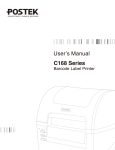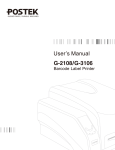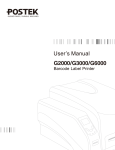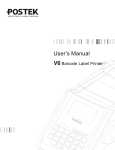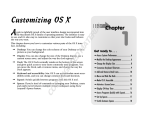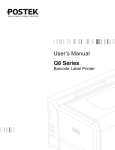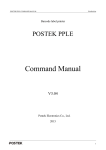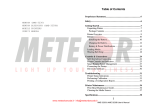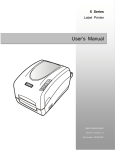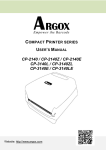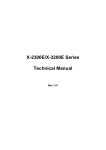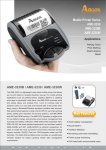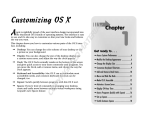Download Chapter 2
Transcript
TX Series User’s Manual
FCC Notice
This device complies with Part 15 of the FCC Rules. Operation is subject to the following two conditions: (1) this device may
not cause harmful interference, and (2) this device must accept any interference received, including interference that may
cause undesired operation.
This equipment may generate, use and/or radiate radio frequency energy. If not installed and used in full accordance with this
instruction manual, interference to radio communications may occur. This equipment complies with the limits for a Class A
Information Technology Equipment pursuant to Part 15 of the FCC Rules, which are designed to provide reasonable protection
against such interference when operated in a commercial environment. Operation of this equipment in a residential area may
also cause interference. In such case the user will be required, at own expense, to correct the interference using whatever
means necessary.
Trademarks
ARM is a registered trademark of Advanced RISC Machines Ltd.
Centronics is a registered trademark of Centronics Data Computer Corporation.
Microsoft, Windows are registered trademarks of Microsoft Corporation.
POSTEK is a registered trademark of Postek Electronics Co., Ltd.
Copyright
© 2008-2015 by Postek Electronics Co., Ltd. All rights reserved. Under the copyright laws, this manual cannot be reproduced
in any form without the prior written permission of Postek. No patent liability is assumed, with respect to the use of the
information contained herein.
TX Series Label Printer User’s Manual
6th edition January 2015
Disclaimer
This manual has been validated and reviewed for accuracy. The instructions and descriptions it contains are accurate for the
Postek TX Series label printer at the time of this manual’s distribution. However, succeeding printers and manuals are subject
to change without notice. Postek assumes no liability for damages incurred directly or indirectly from errors, omissions or
discrepancies between the printer and this manual.
Although this manual describes and details many issues which could possibly occur, the manufacturer cannot warrant against
unpredictable conditions during the printing process. For problems such as the printer not working, lost or unclear print content,
etc., the manufacturer and resellers are responsible for correcting these issues (according to Postek Printer Warranty Clauses).
In no event shall the manufacturer or the resellers involved be liable for any damages whatsoever (including, without
limitation, damages for loss of business profits, business interruption, loss of business information, or other pecuniary loss)
arising from the use of, the results of use or inability to use this product, even if the manufacturer has been advised of the
possibility of such damages.
i
TX Series User’s Manual
Important Safety Instructions
♦ Only qualified and trained service technicians should attempt to repair the printer.
♦ Do not place the printer on or near a heat source.
♦ Be sure that the output of the power adapter is 24VDC and your power source matches the rating listed on the power
adapter. Be certain your power source is grounded.
♦ To avoid getting an electric shock, do not use a worn or damaged power cord. If the power cord becomes damaged or
frayed, replace it immediately.
♦ Do not insert anything into the ventilation slots or openings on the printer.
♦ The printer and power adapter should never be operated in a location where either one can get wet. Personal injury may
result.
♦ The printhead becomes hot while printing. To protect from damaging the printhead and risk of personal injury, avoid
touching the printhead.
♦ To get increased printhead longevity and higher quality printouts, always use approved labels, tags and thermal transfer
ribbons. Approved supplies can be ordered from your Postek authorized reseller.
♦ Static electricity that accumulates on the surface of the human body or other surfaces can damage or destroy the printhead
or electronic components in this device. DO NOT touch the printhead or the electronic components with bare hands.
♦ Place the printer on a flat, firm, solid surface.
♦ Never operate in a high temperature environment.
♦ Turn off the power when not in use for extended periods.
♦ Follow all recommendations and setup instructions included in this manual.
Warnings:
This is a Class A product. In a domestic environment this product may cause radio interference in which case the user may be
required to take adequate measures (see FCC Notice).
Static electricity that accumulates on the surface of the human body or other objects can damage the print head or electronic
components in the TX printer. Observe proper electrostatic safety precautions when handling.
ii
TX Series User’s Manual
Table of Contents
Preface ....................................................................................................................................................................................... 1
Important Notice, Read Me First ............................................................................................................................................ 1
Chapter 1: Introduction ........................................................................................................................................................... 2
Printer Specifications .......................................................................................................................................................... 2
Contents of Box .................................................................................................................................................................. 4
Packing List ................................................................................................................................................................ 4
Chapter 2: Setup and Use ........................................................................................................................................................ 5
Setting up the Printer .......................................................................................................................................................... 5
Main Parts and Structures ........................................................................................................................................... 5
Connecting the Printer ................................................................................................................................................ 9
Interface Connection ................................................................................................................................................. 11
Loading the Ribbon .......................................................................................................................................................... 11
Loading the Media ............................................................................................................................................................ 13
Standard Mode .......................................................................................................................................................... 13
Cutting Mode: ........................................................................................................................................................... 15
Adjusting the Position of Media Sensor ........................................................................................................................... 15
Chapter 3: Operations and Settings ...................................................................................................................................... 17
Basic Operations ............................................................................................................................................................... 17
Power Switch ............................................................................................................................................................ 17
The Front Panel......................................................................................................................................................... 17
LCD Display ............................................................................................................................................................. 18
LCD Panel Operation................................................................................................................................................ 19
Tear-off ..................................................................................................................................................................... 21
Manual Peel-off ........................................................................................................................................................ 22
Cutting Mode ............................................................................................................................................................ 23
Adjusting the Pressure of the Printhead ............................................................................................................................ 26
Windows Driver and Label Software................................................................................................................................ 26
Chapter 4: Maintenance ......................................................................................................................................................... 27
Cleaning the Printhead ...................................................................................................................................................... 27
Cleaning the Platen Roller ................................................................................................................................................ 28
Cleaning the Printer Interior ............................................................................................................................................. 28
Chapter 5: Troubleshooting ................................................................................................................................................... 29
Error Indications ............................................................................................................................................................... 29
Miscellaneous ................................................................................................................................................................... 30
Vertical Blank Lines Appear ..................................................................................................................................... 30
Printer Timeout Error Message ................................................................................................................................. 30
Data Sent but Not Printing ........................................................................................................................................ 30
Poor Printing Quality ................................................................................................................................................ 30
Recovery ................................................................................................................................................................... 31
Appendix A: Interface Specifications .................................................................................................................................... 32
Appendix B: ASCII Table ...................................................................................................................................................... 27
iii
TX Series User’s Manual
Preface, Important Notice
Preface
Your POSTEK TX Series high performance industrial barcode label printer features innovative state-of-the-art technology and
superior quality workmanship. Boasting an all metal frame and unique core construction, the TX achieves a sturdy and durable
stationary platform for smooth printing. A powerful control system can easily handle the most complicated printing
requirements, and advanced thermal transfer/direct thermal technology offers optimum printout clarity.
This manual explains how to set up and begin using your TX Series printer. It also provides detailed information on
configuring your printer, basic operations, care and troubleshooting.
Please read this manual carefully before using the POSTEK TX Series printer.
Important Notice, Read Me First
The thermal printhead can be easily damaged due to its precision construction. A printhead damaged by misuse is not covered
under the terms of the warranty. To ensure longevity of the printhead, please note the following:
1.
2.
3.
4.
5.
6.
DO NOT scrape or use tools that might damage the printhead surface.
To protect from corroding the printhead, DO NOT touch the printhead with bare hands.
DO NOT use thermal paper or thermal transfer ribbons which contain Na, K or Cl.
Keep printhead from any form of liquid or dampness.
Only use a cotton swab dipped in anhydrous isopropyl alcohol to clean the printhead.
Always use high-quality consumables:
• When the printhead module is closed, pressure is placed directly onto the printhead; dirt such as paper scraps, sand,
dust and glue can scrape or damage the printhead.
• The TPH is also easily damaged by static electricity, which may be generated by poor quality ribbons.
7. Always inspect consumables for high quality before purchasing.
Note: The TX Series printer functions under Direct Thermal or Thermal Transfer print methods. Thermal Transfer is set
as the factory default (requires ribbon for printing). However, if you need to print on Direct Thermal materials (ribbon is
not required), please contact your printer supplier or service provider to reduce the printhead pressure. This can protect
your printhead from early performance deterioration due to direct contact with the thermal media. Any physical printhead
damage caused by direct thermal printing is not covered under warranty.
1
TX Series User’s Manual
Chapter 1: Introduction
Chapter 1: Introduction
Printer Specifications
Mode
Printing method
TX2
Thermal Transfer
TX3
TX6
Printing resolution
203 dpi (8 dots/mm)
300 dpi (11.8 dots/mm)
600 dpi (23.6 dots/mm)
Max printing speed
10 ips (254.0 mm/s)
8 ips (203.2 mm/s)
4 ips (101.6 mm/s)
Max printing width
4.09″ (104 mm)
4.17″ (106 mm)
Max printing length
157″ (4000 mm)
79″ (2000 mm)
CPU/Memory
8 MB FLASH ROM, 16 MB SDRAM
Media
Width: 4.56″ (116 mm) max, 0.98" (25mm) or
Width: 4.56″ (116 mm) max, 0.39" (10 mm) min. 0.39" (10 mm) (supporting clip removed) min.
Total thickness (including liner, if any): 0.0024″ Total thickness (including liner, if any): 0.0024″
(0.06 mm) ~ 0.012″ (0.305 mm).
(0.06 mm) ~ 0.012″ (0.305 mm).
Supply roll: OD 8″ (203.2 mm) max. ID 1.5″(38 Supply roll: OD 8″ (203.2 mm) max. ID 3"
mm) min.
(76.2mm) or 1.5″(38 mm) (supporting clip
removed) min.
Ribbon
Max width: 4.65″ (118 mm), Max length: 1968’ (600 m)
Ink side: both In and Out
Ribbon roll: OD 3.3″ (84 mm) max., ID 1″ (25.4 mm) min.
Media sensor
UP&Down Reflective (Adjustable) / Transmissive (Adjustable)
Fonts
Five built-in dot matrix ASCII fonts, user-downloadable TrueType Fonts
Barcode types
1D Barcode: Code 39, Code 93, Code 128/subset A,B,C, Codabar, Interleave 2 of 5, UPC A/E 2
and 5 add-on, EAN-13/8/128, UCC-128, etc;
2D Barcode: MaxiCode, PDF417, Data Matrix, QR, etc.
Interfaces
RS-232 Serial, USB Device 2.0, Centronics Parallel, USB Host, 100/10 Mb Ethernet.
LCD display
Graphic Dot Matrix
Power rating
110/220 VAC ±10%, 50/60 Hz.
Weight
33.06 lbs (15 kgs)
Dimensions
W 11.3″ (286 mm) x D 17.6″ (448 mm) x H 11.0″ (280 mm)
Operation environment
Temperature: 32° F ~ +104° F (0° C ~ 40° C)
Relative humidity: 5% - 85% non condensing
Storage environment
Temperature: -40° F ~ +140° F (-40° C ~ 60° C)
Relative humidity: 5% - 85% non condensing
19.6″ (500 mm)
2
TX Series User’s Manual
Optional items
Chapter 1: Introduction
External Rewinder, and Rotary Cutter.
3
TX Series User’s Manual
Chapter 1: Introduction
Contents of Box
Inspect the shipping carton(s) for possible shipping damage, if damage is discovered, notify the shipping company to report
the nature and extent of the damage.
Please check the items according to the Packing List. If there are any items missing, notify your authorized reseller.
Packing List
TX Series Printer
1 pc
Power Cord
1 pc
USB interface cable
1 pc
Sample Ribbon
1 pc
Sample Media Roll
1 pc
TX Quick Start Guide/Sheet
1 pc
*CD-ROM
1 pc
*Note: CD-ROM pack includes TX printer driver, label design software, TX Series User’s Manual and the Programming
Manual.
TX Series Printer
Media Roll
Ribbon
USB Cable
CD ROM
Power Cord
Quick Start Guide
Figure 1: Printer and Accessories
4
TX Series User’s Manual
Chapter 2: Setup and Use
Chapter 2: Setup and Use
Setting up the Printer
Before setting up the printer consider the following:
1. Make sure there is adequate space around the printer for loading consumables and proper ventilation.
2. Make sure the printer is close to the host so the interface cable is easily accessible at either end.
Main Parts and Structures
10
9
8
7
6
5
4
3
2
1
11
12
Figure 2
1. MENU Button
5. Media Calibration
9. LCD
2. CANCEL Button
6. READY Indicator
10. READY Indicator
3. FEED Button
7. MEDIA Indicator
11. Media Outlet
4. PAUSE Button
8. RIBBON Indicator
12. Cover Handle
5
TX Series User’s Manual
Chapter 2: Setup and Use
Note: The structure of TX3 and TX6 (see figure 3-b) is not exactly same with TX2 (see figure 3-a), the main differences are
in the media compartment, the improved media supporting module in TX3 and TX6 reduces the minimum allowed label
height to only 4mm.
5
6
7
8
4
9
3
10
11
2
1
Figure 3-a
1. Platen Roller
5. Bolt
9.
ESD Brush
2. Printhead Module
6. Positioning Arm – Media Roll
10. Lever
3.
Ribbon Supply Spindle
7. External Media Loading Opening
11. Media Sensor Cover Plate
4.
Ribbon Take-up Spindle
8. Media Spindle
6
TX Series User’s Manual
Chapter 2: Setup and Use
5
6
7
8
4
9
3
10
11
2
1
Figure 3-b
1. Platen Roller
5. Media Roll Guide (out)
9.
ESD Brush
2. Printhead Module
6. Bolt
10. Handle
3.
Ribbon Supply Spindle
7. External Media Loading Opening
11. Media Sensor Cover Plate
4.
Ribbon Take-up Spindle
8. Media Spindle
7
TX Series User’s Manual
Chapter 2: Setup and Use
The Postek TX-Series printer is equipped with multiple interfaces, and the Ethernet Interface is optional. See Figure 4.
4
1
2
6
3
7
5
Figure 4
1. Centronics Port
4. RS-232 Serial Port
2. USB Host
5. AC In Port
3. Ethernet Port
6. USB Device 2.0
7. Power Switch
8
TX Series User’s Manual
Chapter 2: Setup and Use
Loading Path
See figure 5-a shows the loading path in TX2.
4
5
3
2
6
1
7
Figure 5-a
1. Media Sensor Handle
4. Ribbon Path
2. Media Path
5. Ribbon Guide
3. Platen Roller
6. Media Guide Lever
7. Media Guide Slide
Figure 5-b shows the loading path in TX3 and TX6.
4
5
3
2
6
1
7
Figure 5-b
1. Media Sensor Handle
4. Ribbon Path
2. Media Path
5. Ribbon Guide
3. Platen Roller
6. Media Guide Lever
7. Media Guide Slide
9
TX Series User’s Manual
Chapter 2: Setup and Use
Connecting the Printer
Warnings:
(1) Do not use the printer near liquids or corrosive chemicals.
(2) Using the wrong power cord may cause damage to your printer. POSTEK assumes no liability for any damage in such
cases. The rating for the printer is 110/220 VAC ±10%, 50/60 Hz.
1. Make sure the printer is switched OFF.
2. Connect the power cord to the AC Port on the back of the printer.
3. Plug the power cord into a live wall outlet.
10
TX Series User’s Manual
Chapter 2: Setup and Use
Interface Connection
The TX supports RS-232 Serial, USB, Centronics Parallel, Ethernet and USB Host interface connections.
To connect:
1. Make sure the printer is powered OFF.
2. The printer will identify the communication port automatically.
3. The default values of printer port can be obtained from the self-test report. (See Chapter 2: Operation Basics/
Advanced Functions/ Self Test)
4. Cable configurations for Serial (RS-232C) interface is found in Appendix A of this guide.
5. Please take the following measures to reduce cable noise.
- Restrict the length of the interface cable to less than 6’ (1.83 M) if possible.
- Keep the interface cable separate from power cords.
Loading the Ribbon
Note: Load ribbon only when using the thermal transfer printing method. Remove any ribbon that may be loaded when
using the direct thermal printing method.
To install the ribbon:
1.
2.
3.
4.
5.
6.
7.
8.
9.
Lift to open the right cover of the printer.
Turn the handle counter clockwise to release the Printhead Module.
Check the ribbon label to see what side the ink is on. Unwrap the ribbon roll and separate the ribbon roll and the core.
Place the roll into the Ribbon Spindle, adjusting the brackets (see Figure 6). Make sure the ribbon roll is firmly in
place.
Ensuring the ribbon’s ink side is facing the media, lead the ribbon under the Ribbon Guide and past the Printhead
Module (see Figure 7), following the ribbon path indicated in Figure 5.
Secure the leading edge of the ribbon to the core.
Slide the core onto the Ribbon Take-up Spindle to push it firmly to the inside edge of the Spindle.
Turn the Take-up Spindle until the ribbon is tightly wound.
Turn the Lever to the close position.
11
TX Series User’s Manual
Chapter 2: Setup and Use
Ribbon Spindle
Shrapnel
Figure 6
7a
Ribbon
7b
Figure 7
.
12
TX Series User’s Manual
Chapter 2: Setup and Use
Loading the Media
TX Series printers can be operated in three different modes: Standard mode, Peel-off mode, and Cutting mode.
- In Standard mode, each printed label remains on the backing liner.
- In Peel-off mode, each printed label is peeled away from the backing liner manually.
- In Cutting mode, the printer automatically cuts the label after it is printed.
Standard Mode
To load media into the TX2 while using Standard Mode:
1. Lift to open the right cover.
2. Lift the Positioning Arm of the Media Roll, and insert a media roll onto the Media Spindle, pushing it firmly to
the inside edge.
3. Adjust the Positioning Arm by pushing it down and align it to the outside edge of the media roll. Tighten the Bolt
to lock it in place.
4. Turn the Lever counter clockwise to release the Printhead Module.
5. Referring to Figure 5, lead the media under the Media Guide Lever, and in-between the Media Sensor.
6. Pull the media passed and under the Printhead Module (see Figure 7).
7. Move the Media Sensor to the appropriate position (see Figure 8). Adjust the Media Sensor to ensure that its
position is aligned above the media’s separation identifier (e.g. gap, black line, perforation, hole, etc.)
8. Move the Media Guide Slide to the edge of the media, making sure not to pinch or squeeze the media; keep the
media flat and smooth.
9. Turn the lever clockwise to close the Printhead Module;
10. Close the cover and turn on the printer, or press the “FEED” button if the printer is already on.
To load media into the TX3/TX6 while using Standard Mode:
1. Lift to open the right cover.
2. Remove the Media Roll Guide(out), and insert a media roll onto the Media Spindle, pushing it firmly to the inside
edge.
3. Mount back the Media Roll Guide(out) to the outside edge of the media roll. Tighten the Bolt to lock it in place.
4. Turn the Lever counter clockwise to release the Printhead Module.
5. Referring to Figure 5, lead the media under the Media Guide Lever, and in-between the Media Sensor.
6. Pull the media passed and under the Printhead Module (see Figure 7).
7. Move the Media Sensor to the appropriate position (see Figure 8). Adjust the Media Sensor to ensure that its
position is aligned above the media’s separation identifier (e.g. gap, black line, perforation, hole, etc.)
8. Move the Media Guide Slide to the edge of the media, making sure not to pinch or squeeze the media; keep the
media flat and smooth.
9. Turn the lever clockwise to close the Printhead Module;
10. Close the cover and turn on the printer, or press the “FEED” button if the printer is already on.
13
TX Series User’s Manual
Chapter 2: Setup and Use
Sensor position
Media Guide Slide Handle
Figure 8
14
TX Series User’s Manual
Chapter 2: Setup and Use
Peel-off Mode:
To load media into the TX while using Peel-off Mode, use the Standard Mode procedures.
Cutting Mode:
Using the TX in Cutting Mode requires an optional rotary cutter. See an authorized Postek Reseller for additional
information. With the optional rotary cutter, the media loading instructions are provided.
Adjusting the Position of Media Sensor
The TX-Series printer has two types of media sensors: the reflective media sensor and the transmissive media sensor. The
two media sensors are fixed together.
To adjust the position of the media sensors:
1.
2.
3.
Lift the Right Cover.
Twist the Handle counterclockwise to release the Printhead Module.
Lift the Printhead Module to expose the Media Sensor Pointer. See Figure 9.
15
TX Series User’s Manual
Chapter 2: Setup and Use
Handle
Media Sensor Pointer
Media Sensor Handle
Figure 9
4.
Slide the Media Sensor Handle to adjust the position of the Media Sensor Pointer (white arrow), making sure it is
pointing to the label (not anywhere outside of the label).
Turn the Handle clockwise to close the Printhead Module.
16
TX Series User’s Manual
Chapter 3: Operations and Settings
Chapter 3: Operations and Settings
Basic Operations
Power Switch
The power switch is on the back panel of the printer. The symbols on the switch are defined as follows:
━ —ON
〇 —OFF
The Front Panel
The Front Panel of the TX printer consists of:
- Three Indicator Lamps: MEDIA, READY and RIBBON
- Three multi function buttons: PAUSE, FEED and CANCEL
Indicator Lamps
The three lamps indicate the status of the printer (please refer to Chapter 4: Troubleshooting, for error indicators).
READY
- Solid: Indicates the printer is in the normal state;
- Blinking: Indicates the printer is in the ‘PAUSE’ state.
MEDIA
- Solid: Indicates the printer is in the normal state;
- Blinking simultaneously with READY: Running out of media;
RIBBON
- Solid: Indicates thermal transfer printing;
- Off: Direct thermal printing (no ribbon installed);
- Blinking simultaneously with READY: Running out of ribbon.
17
TX Series User’s Manual
Chapter 3: Operations and Settings
Panel Buttons
The five buttons have different functions based on the mode of the operation is performed.
Mode
Function
FEED
Feed one label
PAUSE
- Press once to pause current print job
- Press a second time to resume printing
CANCEL
- Cancel current batch of labels
- Forces the printer to continue working after an error has been corrected
MEDIA CALIBRATION
Performs media sensor calibration
MENU
Enter/exit setup menu
LCD Display
A graphic dot matrix LCD display is affixed to the front panel. Data in the form of characters, letters and numbers are shown on
the LCD display. Please see below “LCD Panel Operation”.
18
TX Series User’s Manual
Chapter 3: Operations and Settings
LCD Panel Operation
The LCD can display the printer’s status, total print quantities, error messages, and is also valuable when configuring the
printer. Following are common examples of LCD displays.
Ready [203DPI]
Total: 888
Version: 1.52
2014-02-01 08:08:08
Pause
Total: 888
Version: 1.52
2014-02-01 08:08:08
Ready Status [Resolution]
Total printed labels count, will be
reset to 0 if cycle the printer power.
Firmware Version
Current Date
Current Time
Pause Status
Total printed labels count, will be
reset to 0 if cycle the printer power.
Firmware Version
Current Date
Current Time
Settings Menu
XXXX is the name of the
currently selected option, icons in
the middle represents different
settings options.
Selected/Total (Option Number)
XXXX
01/36
XXXX
12
Changing An Option’s Value
XXXX is the name of the
activated option.
Status Bar and Value.
Button functions:
BUTTON
FUNCTION
DESCRIPTION
MENU
Enter/exit
Enter/exit setup mode
PAUSE
Item/Parameter Selection
Descending Item/Parameter selection
CANCEL
Item/Parameter Selection
Increasing Item/Parameter selection
FEED
Confirmation
Confirm selection
19
TX Series User’s Manual
Chapter 3: Operations and Settings
Items to be set and operating guide:
SUB MENU
DESCRIPTION
Exit
Exit from the menu, with or without saving the changes.
Darkness
When set at ‘0’, the printer will accept the default setting or command setting, if not, the
printer will not accept the default setting or command setting.
Speed
Language
Options: English, Chinese
Default: English
Print Method
Direct Thermal, Thermal Transfer.
Default: Thermal Transfer.
Tear Off
Cutter
Options: Enable, Disable.
Default:: Disable.
Manual Peel Off
Media Sensor Type
Options: Down Reflective, Up Reflective, Transmissive.
Default:: Down Reflective.
Baud Rate
Options: 9600, 19200, 38400, 57600.
Default:: 38400.
Data Bit
Options: 7 Bit, 8 Bit.
Default: 8 Bit.
Parity
Options: None, Odd, Even
Default: None.
Tear-off Offset
Positioning Offset
The increment, per TX model are as follows:
Cutting Offset
–
–
–
Peeling Offset
Horizontal Offset
TX2 is 0.125mm
TX3 0.085 mm,
TX6 is 0.0423 mm.
Vertical Offset
Cutting Frequency
After the specific copies of labels printing will the cutter cut once.
Default value: 01.
Error Report
Allow or forbid the printer to send back error information to the host.
Options: Enable, Disable
IP Address
Gateway
The range of XXX is 0-255, press PAUSE
to decrease, CANCEL
to move to next XXX. Upon completion, pressing FEED
FEED
to the “Save/Abort” screen.
to increase,
will proceed
Subnet Mask
Port
Set Date
Set system date.
Set Time
Set system time.
View Fonts
Browse the stored fonts.
Delete Fonts
Delete stored fonts.
Command Type
Options: PPLE, PPLZ
Default: PPLE
20
TX Series User’s Manual
Chapter 3: Operations and Settings
DHCP
Options: Enable, Disable
Default: Disable
After DHCP is enabled, the printer will ask for a restart. As the printer being powered on
again, the LCD will prompt “DHCP CONFIGURING, PLEASE WAIT…” Normally it
takes 2 minutes to finish the network settings. If failed, the printer will disable the DHCP
and prompt “DHCP DISABLED, CHECK CONNECTIONS!”
For printers with firmware versions before V6.28, LCD displays “INITIALIZING PLEASE
WAIT…”
Dump Mode
Options: Enable, Disable
Default: Disable
Detect Length
The Media feed length when perform Media Calibration.
Default 200, Unit mm.
Offline Printing
Browse the pre-stored label forms, select one to print.
Clear Form
Clear the forms downloaded to the printer.
Clear Graphic
Clear the graphics downloaded to the printer.
Clear Setting
Clears only those settings accomplished through the front panel.
* Please read the content in “Important Notice” section before setting your printer to direct thermal mode.
Tear-off
a. Grab printed label
b. Tear down
Figure 9
1. Press MENU to enter setup menu: Common Settings → Tear Off, select Enable.
2. Follow the directions shown in Figure 9 to tear off the label.
3. If the tear-off position needs to be adjusted, press MENU to enter setup menu: Offset Settings → Tear-off Offset, input
suitable offset value.
21
TX Series User’s Manual
Chapter 3: Operations and Settings
Manual Peel-off
a. Press the printed label downwards
b. Press the label to printer
c. Remove the label
Figure 10
1.
2.
3.
4.
Press MENU to enter setup menu: Manual Peel Off, select Enable.
Follow the directions shown in Figure 10 to peel off the label.
Press PAUSE to print next label.
If the peeling position needs to be adjusted, press MENU to enter setup menu: Peeling Offset, input suitable offset
value.
22
TX Series User’s Manual
Chapter 3: Operations and Settings
Cutting Mode
Note: The Rotary Cutter Kit is an optional accessory.
1. Turn on the printer and enter the Setup Menu by pressing the Setup/Exit button on the Front Panel.
2. Enable the cutter under the LCD menu.
3. Reset the printer: press and hold the Cancel button for 4 seconds, the three lamps will blink simultaneously. Release
and press the Cancel button again, the three indicators stop blinking and remain lit. The printer is now in its normal
state (see Figure 11).
4. With media loaded, the cutter is now ready to use (see Figure 12-a and 12-b).
Figure 11
23
TX Series User’s Manual
Chapter 3: Operations and Settings
Figure 12-a
Cutting Mode- TX2
24
TX Series User’s Manual
Chapter 3: Operations and Settings
Figure 12-b
Cutting Mode- TX3/TX6
25
TX Series User’s Manual
Chapter 3: Operations and Settings
Adjusting the Pressure of the Printhead
1
2
Figure 13
As shown in Figure 13, there are two screws, #1 and #2. Unscrew #2 first, but do not remove it. Then, unscrew #1. Adjust the
position of screw #1 towards Increase or Decrease as required. Then first fasten screw #1, then the #2.
Windows Driver and Label Software
The TX Series Industrial printer driver is packaged with the printer in the CD-ROM pack, and is compatible with the
following operating systems:
• Windows 8
• Windows 7
• Windows XP
• Windows Vista
• Windows ME
• Windows 98
• Windows 2000
• Windows 2003
• Windows 95
• Windows 2008
• Windows NT
Drivers can also be downloaded from www.postek.com.cn and www.postektechnologies.com
Each TX Series Industrial printer is also packaged with powerful barcode label editing software.
26
TX Series User’s Manual
Chapter 4: Maintenance
Chapter 4: Maintenance
Warnings:
(1) Make sure the printer is powered off before performing maintenance operations.
(2) The Printhead may be hot due to recent printing. Wait until the Printhead cools before performing maintenance.
(3) Use only anhydrous isopropyl alcohol to clean the print head.
Cleaning the Printhead
The Printhead is the mechanism that enables the ink to impact the label. Due to the Printheads precision construction and
necessary location in the printer, it comes into contact with consumables and therefore is susceptible to dirt accumulation. If
dirt is not removed, the Printhead may be damaged. To ensure longevity of the Printhead, follow the recommended
maintenance guidelines below:
Note: A Printhead damaged by misuse is not covered under warranty.
1.
2.
3.
4.
5.
6.
7.
Clean the Printhead
Clean the Printhead after every (1) roll of ribbon use or every (3) rolls of label media use. To clean the Printhead:
Turn printer power off
Open the top cover of the printer
Turn the handle to open.
Remove the ribbon (if applicable) and media
Use a cotton swab dipped in anhydrous isopropyl alcohol. Rub the swab along the Printhead until the swab no longer
accumulates ink
8. Let the Printhead dry before using the TX again
27
TX Series User’s Manual
Chapter 4: Maintenance
Cleaning the Platen Roller
The Platen Roller, located at the exit point and underneath labels, supports the labels as they feed out of the printer. The
roller can accumulate debris from consumables, such as dirt, sand, dust or glue. To ensure longevity of the Platen Roller,
follow the recommended maintenance guidelines below:
Clean the Platen Roller after every (3) rolls of label media used. To clean the Platen Roller:
1.
2.
3.
4.
5.
Turn off the printer.
Open the top cover.
Release and lift the Printhead Module
Remove the ribbon (if applicable) and media.
Use a cotton swab dipped in anhydrous isopropyl alcohol. Rub the swab along the Platen Roller while rotating the roller
until the swab no longer accumulates ink or debris.
Cleaning the Printer Interior
Over time, the printer’s interior may collect dust or debris from the consumables. It is advised to periodically clean the
printer’s interior in order to prevent the accumulated debris from damaging internal parts.
To clean the printer interior, use a cotton swabs dipped into anhydrous isopropyl alcohol and remove any debris.
28
TX Series User’s Manual
Chapter 5: Troubleshooting
Chapter 5: Troubleshooting
Occasionally situations occur that require some troubleshooting. Possible issues and potential solutions are listed in this
section. While not every situation is addressed, you may find some of these tips useful.
Error Indications
Typically, when the printer is not functioning, one or two of the three indicator lamps will begin blinking. The possible
situations addressed by the status of the three indicator lamps are listed bellow.
READY and MEDIA Lamps blink simultaneously:
Possible Cause
Media sensor cannot detect labels
Media ran out
Media jammed
The Media Roll Guides are not firmly
positioned against the Media or have not
been installed.
Media sensor is broken
Recommended Solutions
a) Check and confirm the media has been loaded correctly
b) Check the position of the media sensor and confirm it could detect the
media gap or black line
c) Calibrate the media sensor
d) If using continuous media, ensure correct settings in chosen in the label
software
Load a roll of media
Clear the jam
Install the Media Roll Guides correctly and press them firmly press the
media.
Contact an authorized POSTEK service provider for technical support.
Note: If you are using continuous media without gaps or black lines, please make sure the correct Media Type settings are
input in PosLabel software.
READY and RIBBON Lamps blink simultaneously:
Possible Cause
Ribbon ran out
Ribbon jammed
Ribbon Sensor error
Recommend Solutions
Load a new roll of ribbon
Clear the jam
Contact an authorized POSTEK service provider for technical support.
Only READY Lamp blinks:
Possible Cause
Recommend Solutions
Serial I/O error
Check LCD menu for the baud rate settings
Memory overflow
a) Restart the printer
b) Reset the printer
29
TX Series User’s Manual
Chapter 5: Troubleshooting
Miscellaneous
Vertical Blank Lines Appear
If the printer prints vertical blank lines as shown in the below picture, it may be due to a dirty or defective Printhead. See the
table below for possible causes and solutions.
Cause
The Printhead is dirty.
Vertical lines still appear after cleaning the
Printhead.
Corrective Action
Clean the Printhead. Follow the recommended maintenance guidelines for
cleaning the Printhead.
Contact an authorized POSTEK service provider for technical support.
Printer Timeout Error Message
Execute following corrective actions:
1. Check the interface cable for proper connection.
2. Ensure the TX printer is powered on.
If the trouble still exists, please contact an authorized POSTEK service provider for technical support.
Data Sent but Not Printing
1. Ensure the correct driver is chosen in the label software.
2. Reset the TX printer.
If the trouble still exists, please contact an authorized POSTEK service provider for technical support.
Poor Printing Quality
When experiencing poor print quality, check the following:
1.
2.
3.
4.
5.
Adjust print darkness setting value.
Adjust print speed setting value.
Clean the Printhead and the platen roller.
Poor quality printing may be caused from using a low quality ribbon. Change to higher quality ribbon.
Poor quality printing may be caused from using low quality media. Change to higher quality media.
30
TX Series User’s Manual
Chapter 5: Troubleshooting
Recovery
After the miscellaneous has been cleared, press the CANCEL button to clear the alarm or restart the printer to resume the
printing automatically.
Note: For errors not listed here, please contact an authorized POSTEK Service Provider for further assistance.
31
TX Series User’s Manual
Appendix A: Interface Specifications
Appendix A: Interface Specifications
RS232 Serial
The RS232 connector on the printer is a DB9F:
Pin
Direction
1
/
2
Out
3
In
4
In
5
6
Out
7
In
8
Out
9
/
Definition
/
TX
RX
CTS
Ground
RTS
DSR
DTR
/
Connection with host:
Host 25S
TX 2
RX 3
DSR 6
DTR 20
RTS 4
CTS 5
GND 7
………
………
………
………
………
………
………
Printer 9P
3 RX
2 TX
8 DTR
7 DSR
4 CTS
6 RTS
5 GND
Host 9S
RX 2
TX 3
DTR 4
DSR 6
RTS 7
CTS 8
GND 5
………
………
………
………
………
………
………
Printer 9P
2 TX
3 RX
7 DSR
8 DTR
4 CTS
6 RTS
5 GND
Alternately you can just connect the 3 wires as follows:
Host 25S
TX 2
RX 3
GND 7
pin 4
pin 5
pin 6
pin 20
–
–
–
–
–
Printer 9P
……… 3 RX
……… 2 TX
……… 5 GND
Host 9S
RX 2
TX 3
GND 5
pin 4
pin 6
pin 7
pin 8
Printer 9P
……… 2 TX
……… 3 RX
……… 5 GND
Baud rate: 9600, 19200, 38400, 57600
Data format: always 8 data bits, 1 start bit and 1 stop bit.
Parity: always non parity.
Flow control: RTS/CTS (Hardware flow control).
If you are using software or drivers under the Windows environment, the flow control must be set to “hardware.”
Any communications port can transmit data from the host (RS232, Ethernet, or USB). Preliminary communications
settings are not required since the printer will automatically detect which port is active.
Note: Never send data from 2 ports at the same time. Data cannot be sent to more than one port simultaneously or data
corruption and print errors may occur.
32
TX Series User’s Manual
Appendix B: ASCII Table
Appendix B: ASCII Table
0
1
2
3
4
5
6
7
8
9
A
B
C
D
E
F
0
NUL
SOH
STX
1
2
XON
!
“
#
$
%
&
‘
(
)
*
+
,
.
/
XOFF
NAK
ACK
BEL
BS
LF
ESC
FF
CR
SO
SI
RS
US
3
0
1
2
3
4
5
6
7
8
9
:
;
<
=
>
?
4
@
A
B
C
D
E
F
G
H
I
J
K
L
M
N
O
5
P
Q
R
S
T
U
V
W
X
Y
Z
[
\
]
^
_
6
`
a
b
c
d
e
f
g
h
i
j
k
l
m
n
o
7
p
q
r
s
t
u
v
w
x
y
z
{
|
}
~
DEL
Note: The € sign is included in the embedded table at DEC128 or HEX 80
27






































